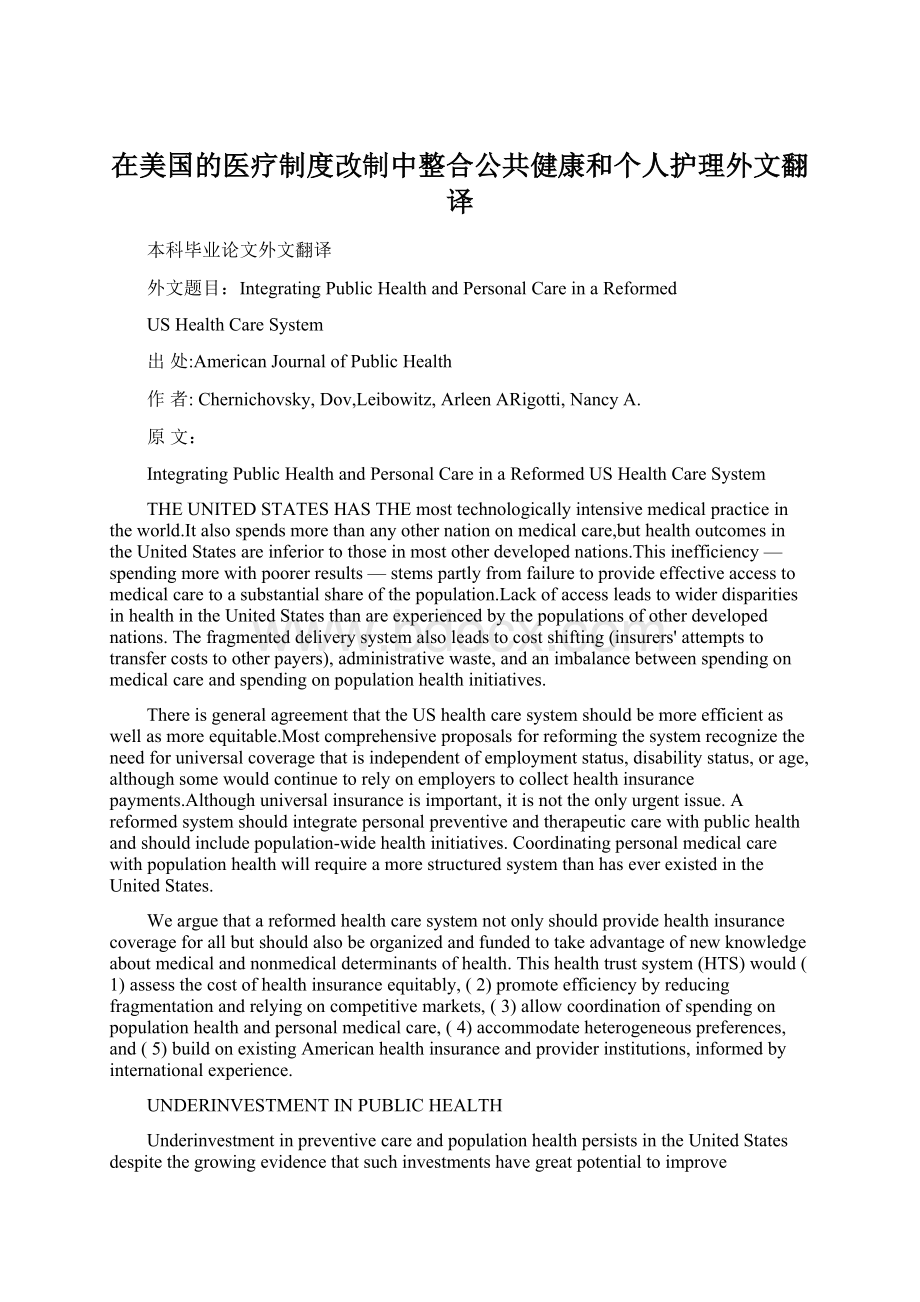 在美国的医疗制度改制中整合公共健康和个人护理外文翻译文档格式.docx
在美国的医疗制度改制中整合公共健康和个人护理外文翻译文档格式.docx
- 文档编号:18610930
- 上传时间:2022-12-29
- 格式:DOCX
- 页数:8
- 大小:25KB
在美国的医疗制度改制中整合公共健康和个人护理外文翻译文档格式.docx
《在美国的医疗制度改制中整合公共健康和个人护理外文翻译文档格式.docx》由会员分享,可在线阅读,更多相关《在美国的医疗制度改制中整合公共健康和个人护理外文翻译文档格式.docx(8页珍藏版)》请在冰豆网上搜索。

IntegratingPublicHealthandPersonalCareinaReformed
USHealthCareSystem
出处:
AmericanJournalofPublicHealth
作者:
Chernichovsky,Dov,Leibowitz,ArleenARigotti,NancyA.
原文:
IntegratingPublicHealthandPersonalCareinaReformedUSHealthCareSystem
THEUNITEDSTATESHASTHEmosttechnologicallyintensivemedicalpracticeintheworld.Italsospendsmorethananyothernationonmedicalcare,buthealthoutcomesintheUnitedStatesareinferiortothoseinmostotherdevelopednations.Thisinefficiency—spendingmorewithpoorerresults—stemspartlyfromfailuretoprovideeffectiveaccesstomedicalcaretoasubstantialshareofthepopulation.LackofaccessleadstowiderdisparitiesinhealthintheUnitedStatesthanareexperiencedbythepopulationsofotherdevelopednations.Thefragmenteddeliverysystemalsoleadstocostshifting(insurers'
attemptstotransfercoststootherpayers),administrativewaste,andanimbalancebetweenspendingonmedicalcareandspendingonpopulationhealthinitiatives.
ThereisgeneralagreementthattheUShealthcaresystemshouldbemoreefficientaswellasmoreequitable.Mostcomprehensiveproposalsforreformingthesystemrecognizetheneedforuniversalcoveragethatisindependentofemploymentstatus,disabilitystatus,orage,althoughsomewouldcontinuetorelyonemployerstocollecthealthinsurancepayments.Althoughuniversalinsuranceisimportant,itisnottheonlyurgentissue.Areformedsystemshouldintegratepersonalpreventiveandtherapeuticcarewithpublichealthandshouldincludepopulation-widehealthinitiatives.CoordinatingpersonalmedicalcarewithpopulationhealthwillrequireamorestructuredsystemthanhaseverexistedintheUnitedStates.
Wearguethatareformedhealthcaresystemnotonlyshouldprovidehealthinsurancecoverageforallbutshouldalsobeorganizedandfundedtotakeadvantageofnewknowledgeaboutmedicalandnonmedicaldeterminantsofhealth.Thishealthtrustsystem(HTS)would
(1)assessthecostofhealthinsuranceequitably,
(2)promoteefficiencybyreducingfragmentationandrelyingoncompetitivemarkets,(3)allowcoordinationofspendingonpopulationhealthandpersonalmedicalcare,(4)accommodateheterogeneouspreferences,and(5)buildonexistingAmericanhealthinsuranceandproviderinstitutions,informedbyinternationalexperience.
UNDERINVESTMENTINPUBLICHEALTH
UnderinvestmentinpreventivecareandpopulationhealthpersistsintheUnitedStatesdespitethegrowingevidencethatsuchinvestmentshavegreatpotentialtoimprovehealth.Highratesofreturnhavebeendemonstratedforcommunity-levelinterventionstoreducethehigh-riskbehaviorsthatpromotechronicdiseases,whichaccountfortwothirdsofalldeathsintheUnitedStatesandahigherpercentageofdeathsamongthemostdisadvantagedgroups.Thesechronicdiseasesareoftenassociatedwithhigh-risklifestyleconsumptionchoices(smoking,drinking,andpoordiet),whichmaybemoreeffectivelyavertedbypolicyinterventionsinthecommunityandearlyinthelifecoursethanalteredbylaterinterventionswithinthemedicalcaresector.Forexample,2structuralinterventionsinCalifornia—levyingacigarettetaxandbanningindoorsmokinginpublicplaces—resultedindramaticdeclinesinsmoking,followedbydeclinesintheratesoflungcancerandheartdiseaseinthestate.Disadvantagedpopulations,whichbearthegreatestburdenofchronicdisease,standtobenefitmostfrompublicandpopulationhealthinterventions.
ThecurrentfinancingstructureandorganizationofcareintheUnitedStatesprovidestrongincentivestotreatillnessafteritoccursratherthantoinvestinprevention.Healthinsurancepoliciesalsoencourageasuboptimalmixofservices,relyingonexpensive,andoftenredundant,technology,withinadequatecoverageforpreventivecare.Thefragmentedhealthcarefinancingsystemalsowastesresourcesthroughcostshiftingandexcessiveadministrativcosts.
Tocreateamoreeffectiveandefficienthealthcaresystem,theUnitedStatesshouldcapitalizeoncurrenthealthreformeffortsthataimtomakeaccesstocareuniversalandcontainitscostswithinanintegratedhealthsystem.Thiswillrequireredesigningthesystemtoallocateresourcestotherapeuticcareandtopopulationhealthinabalancethatmorecloselyreflectstheirabilitiestopromotehealthandtherebyincreasesthehealthreturnsgeneratedbyhealthexpenditures.
ARCHITECTUREOFANINTEGRATEDHEALTHSYSTEM
Inadditiontoprovidinguniversalaccessandequitablefunding,areformedhealthsystemshouldstriveto
(1)increaseefficiencybyformulatingcoherentpolicywithappropriateincentives,information,andsupportinginfrastructure;
(2)fostercoordinationofpublic,population,andprivatehealthcareatthelocallevel;
(3)imposefinancialdiscipline,orcostcontainment;
and(4)encouragechoicefor,andresponsivenessto,clients.
Weproposeahealthsystemconsistingofanationalindependentbody,anationalhealthtrust(NHT),whichwouldcoordinateregional-orstate-basedaffiliates-regionalhealthtrusts(RHTs)—andwhichwouldformacoherentnationalstructuretoensureorderlyandefficientoperation.
ADVANTAGESANDSAFEGUARDSINAHEALTHTRUSTSYSTEM
MostofthepoliticaldiscussionofhealthcarereformintheUnitedStateshascenteredonthecrisisinhealthcarecostsandtherelatedlackofaccesstoqualitymedicalcare.Theseimportantissuesare,however,partofalargerproblem:
thecurrentinabilityoftheUnitedStatestocareforthehealthforitspopulationefficientlybecauseitlacksacoherentsystemforfinancingandprovidingmedicalcareaswellasamechanismforallocatingresourcesbothtomedicalcareforindividualsandtopublicandpopulationhealthinitiatives.Ourproposalwouldcreatealogical,nestedorganizationthatwouldbuildonthefoundationsofthecurrentUShealthcaresystem.
Ourproposedstructurewouldhaveseveralfundamentaladvantages.Itcouldensurethathealthspendingwouldbetargetedtoitsmostproductiveusesandthatdecisionmakerscouldtakeamoreappropriatelong-termperspectiveonthehealthofAmericansbyinvestingnowinpreventionandhealthpromotion,whilealsoprovidingmedicalcareequitablytoallAmericans.Suchasystemwouldreducebillingcostsandadministrativewastebyeliminatingmedicalunderwriting,duplicatecoverage,andcostshifting.Inaddition,therebalancingofpersonalandpopulationhealthinitiativesandthedevelopmentanddisseminationofinformationontheconstituentsofcost-effectivehealthcarewouldacttocontrolcosts.
Universality
TheproposedHTSpromiseseveryAmericanaportable,basicpackageofcorebenefits,independentofemploymentstatus,whichwouldcomprisepersonalandpopulationservicesforpreventionandtreatment.ThisHTSwouldmainstreamthecareoflow-incomepersonscurrentlyenrolledincategoricalprogramsforpeoplewithparticularcharacteristics,suchasMedicaidforthedisabled,theStateChildren'
sInsuranceProgramforchildren,orRyanWhiteCareActprogramsfortreatmentofHIV/AIDS.UnderanHTS,avoucherwouldsupportenrollmentofthecategoricallyeligibleinanyplanofferedintheirarea,therebyexpandingtheirchoiceofproviders.Plans'
incentivestofavorlow-riskapplicantswouldbemitigatedbyreceiptofarisk-adjustedcapitationpaymentthatwouldbeindependentoftheenrolleecontribution.
Universalitydoesnotimplyuniformcare,eitherincontentorinform.InanHTS,individualswouldhaveagreaterchoiceofprovidersthaniscurrentlyavailabletomostAmericans.Althougheveryonewouldbeguaranteedthesamecorebenefits,individualscouldsatisfydiversepreferencesbysupplementingthecorebenefitswiththeirpersonalfunds,withinthesamehealthsystem,muchasFEHBPenrolleescurrentlydo.Althoughthisarrangementmayraisethespecterofa2-tieredsystem,supplementationhasnotbeenamajorissueintheFEHBP.Someindividualsnowhavebenefitsthatexceedthecorebenefitsthatcanbeprovideduniversally.Allowingthemtosupplementthecorebenefitpackageandkeeptheircurrenthealthinsuranceiftheypreferitmaybenecessaryforpoliticalacceptability.
TheorganizationofhealthcoverageintheNetherlandsprovidesaprototypeforthetypeofsystemweadvocate.Dutchresidentsreceivearisk-adjustedvoucherforabasicbenefitpackage,purchasedfromcompetinginsurers.Theycansupplementthecorebenefitsthroughtheirownresourcesorfundingfromtheiremployer.TheNetherlandscombatsrisksegmentationbycompensatingplanswithhighlydevelopedrisk-adjustedcapitationpayments.
Governance
AnHTSwouldfinanceuniversalcoveragethroughmandatedcontributionsbutwouldrelyonprivateproviderstosupplymedicalcare.Itwouldnotresemblesocializedmedicine.Thefederalgovernmentwouldinfactremaindistantfromtheorganizationandmanagementofthesystem,letalonethemanagementandprovisionofcare.However,toensurethatplansassumeafiduciaryroleonbehalfofthepublic,theNHTandRHTswouldhavetocarefullymonitorthathealthplansareprovidingappropriatecareandnotengaginginriskselection.
ThebasicnatureofUShealthcareprovisionwouldremainintact,andallAmericansenrolledinaninsuranceplanofanytypecouldcontinuetoreceivecareinthesamemannertheyreceiveittoday,althoughfundingsourceswouldchange.Theproposedplanwouldrelyheavilyonprivate,nongovernmentalentitiestoinsurethecorebenefitsaswellastooffersupplementalinsurance.Specializedgovernment-runprogramssuchasMedicareandMedicaidcouldremaininplaceandfunctionashealthplans,a
- 配套讲稿:
如PPT文件的首页显示word图标,表示该PPT已包含配套word讲稿。双击word图标可打开word文档。
- 特殊限制:
部分文档作品中含有的国旗、国徽等图片,仅作为作品整体效果示例展示,禁止商用。设计者仅对作品中独创性部分享有著作权。
- 关 键 词:
- 美国 医疗 制度 改制 整合 公共 健康 个人 护理 外文 翻译
 冰豆网所有资源均是用户自行上传分享,仅供网友学习交流,未经上传用户书面授权,请勿作他用。
冰豆网所有资源均是用户自行上传分享,仅供网友学习交流,未经上传用户书面授权,请勿作他用。


 对中国城市家庭的教育投资行为的理论和实证研究.docx
对中国城市家庭的教育投资行为的理论和实证研究.docx
